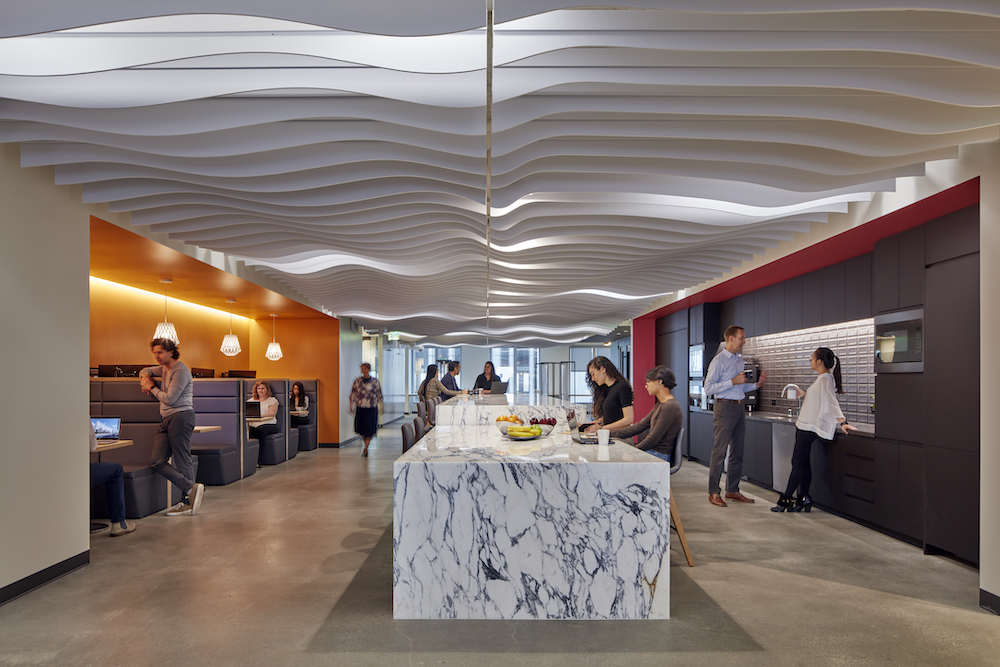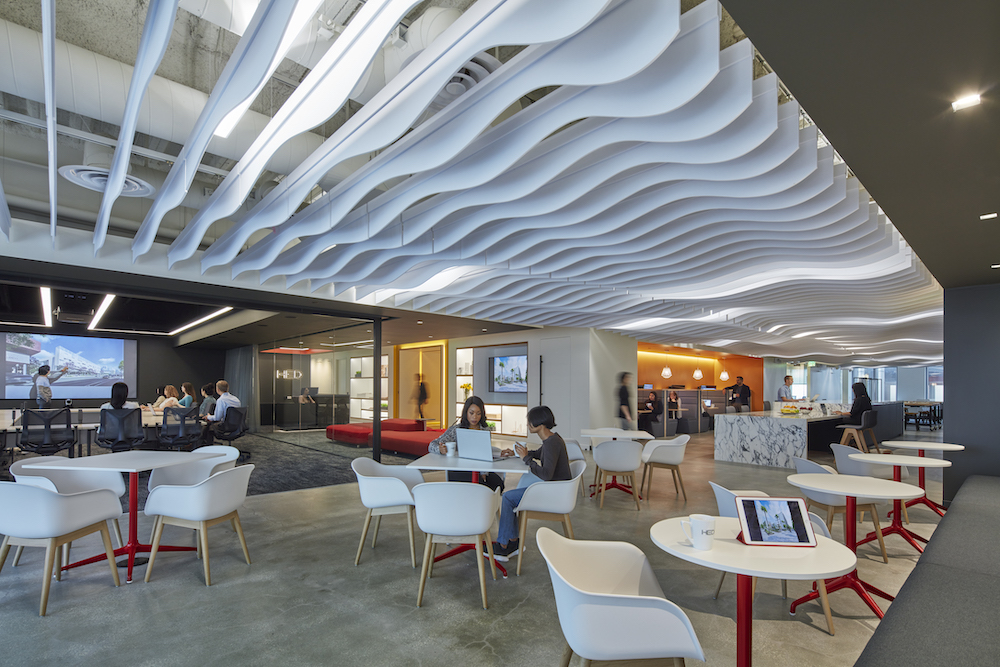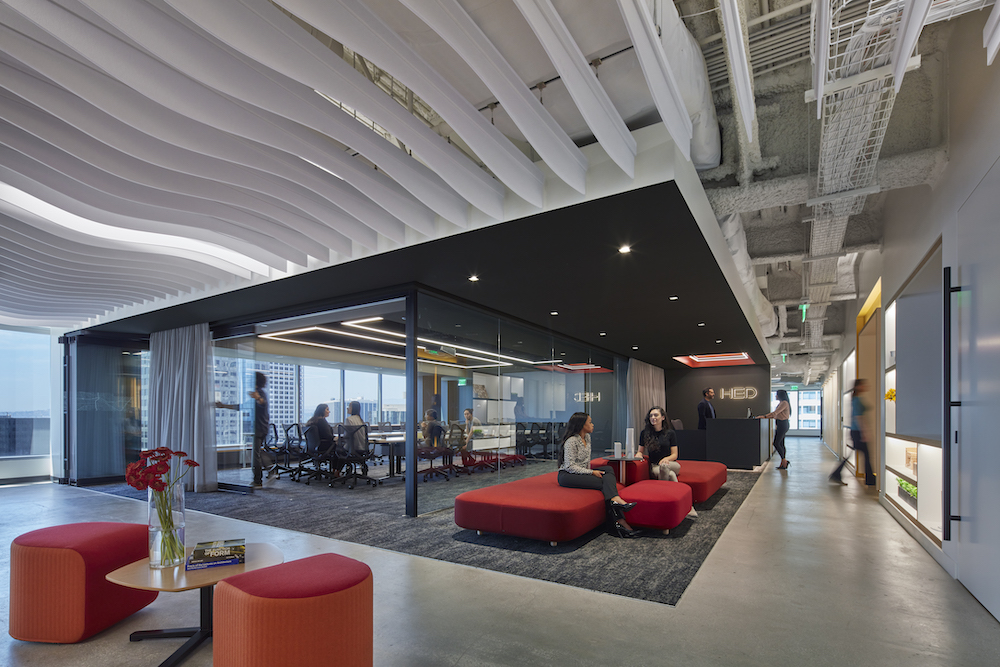Tim Gawel of HED shares 5 tips to create flexible, alternative workspaces.
Work, how we work and what employees expect from work has transformed. We have seen spaces built to enhance hybrid, flexible and alternative work outperform more traditional spaces over the last several years. This has resulted in organizations doubling down on flexibility and alternative space planning as a strategic recruiting benefit and embracing square-footage reduction as a cost savings.
Hybrid, or at a minimum, highly flexible workplaces will continue to be preferred options, which calls for a greater investment in alternative workspaces and flexible design choices in coming years. To successfully craft hybrid offices, we recommend going into the process with no preconceived notions, collecting data from your team on what they want in an office, embracing the virtual and hybrid models, using acoustics to limit distractions and implementing several types of workspaces. In our time curating top hybrid offices, we have used the tips below to ensure a successful transition.
Design Spaces to Fit Your Office’s Needs
For organizations leading their industries, the desire to bring people back to the office is about driving workplace innovation. Success in bringing people back to the office requires an understanding of how your team best accomplishes work. To coax people into the office and encourage innovation, alternative work models should be carefully planned and selected to fit the type of work being performed, suit the culture of the organization and create connections.
If the office helps people perform their work rather than just acting as the setting their work happens in, and makes them feel comfortable and connected, enforcing attendance policies won’t be necessary. Companies should seek answers to questions like: “What type of space are we using? What is the quality level? What’s effective?” to find their balanced mix of space types. For companies with varied responses, try flexible, multi-sized spaces
Flexible, Multi-Sized Spaces
Offering the opportunity to focus while being hub adjacent or nearby a more open mixed-seating area. These spaces can take the form of booths, small tables or other flexible seating for solo, dual or small group collaboration and provide for rapid collaborative work by allowing small groups to form and break apart as time demands.

Leverage Data
Until now, some organizations approached facilities through trial and error. In a modern, flexible workplace, organizations must be deliberate when selecting the types and number of alternative workspaces that will be made available. Analysis, user-feedback, prototype and space concept testing, data driven design and real estate utilization studies must become the norm for alternative workspaces to deliver on the promise of a next generation workplace.
Bringing team members together to give opinions and feedback on what they want in an office gives employees ownership in the new design. Hesitant employees are more likely to want to come to the office knowing it was designed with them in mind. To gather employee insights, designers can use virtual surveys, in-person walk throughs or a combination of both. Many companies have found that their team members’ top reason to be in the office is for collaboration and socialization with colleagues. Open collaboration hubs provide space to gather, brainstorm and be together.
Open Collaboration Hubs
A hub is perfect for large events and promoting social interaction. It can be used as large meeting space, training space and gathering place.


Embrace Virtual
In a hybrid work environment, expecting the stars to align for every team member to come into the office on the same day is unrealistic. Incorporating technology suites with multiple shifting displays to transform the office into a virtual experience is a must. Small meeting suites should be equipped with technology that fits your team’s needs (i.e. rapid video/audio connectivity to their laptops and tablets) when hosting or attending an engaging virtual meeting. This helps employees work together consistently while in different locations. Robust in-office Wi-Fi is essential to the movement that will allow teams to utilize the entire space, and strategic video/audio resources should be made available.
Single Occupancy Suites or Tucked Away Nooks
Enclosed or tucked farthest from the main collaboration area for acoustic protection, these spaces can be booth-like single occupant suites or open space designated for heads-down focused work. It is important to have at least a few quiet areas and a handful of spaces specifically to conduct distance-collaboration calls without distracting others.

Consider Acoustics
Noise was already a top complaint from organizations that previously embraced open office designs. Prior to the pandemic, the trend for workplace design was to open the space with minimal private offices to take advantage of density, drive better access to daylight and establish a more connected workplace. The results were noisy open offices with people sitting at tables with headphones on if they needed to concentrate.

Now with hybrid schedules, inter-office teams and the necessity of virtual calls and meetings, the office is still a noisy place. To handle the mix of virtual and in-person meetings, offices should create auditory privacy wherever you have established an area for virtual calls or meetings. For the best acoustics, shared or collaborative hub spaces should be purposefully oriented to not clash with more private working and focused spaces. As we evolve, workplace cultures will need to help self-govern the importance of acoustic awareness as people continue to find new ways of meeting and working virtually.
Large Meeting Rooms
For large group collaboration, these spaces should be technology enabled and acoustically private to accommodate distance-collaboration.

Small meeting suites
For small group collaboration, these smaller group spaces should be just as technology enabled and acoustically private as a larger meeting space.


It’s Not One Workspace, it’s Many Workspaces
Lastly, it’s important to remember the workplace is no longer one setting where everyone comes to do work. It is a collection of settings where people come to perform lots of different work. The average office-worker manages a shifting tide of local collaboration, distance collaboration, focused work, reporting or supervisory check ins and client/vendor/consultant management each week. No one day is the same, and it isn’t feasible to say that all of someone’s focus work can or will take place on the 2-3 days they work from home. In the same vein, we can’t say that no inter-office or international calls will occur on an in-office day where we’d prefer everyone collaborate with their local team.
The optimal way to conduct in-office days must be mobile, autonomous, and adaptive to the tasks and personalities at hand. Some individuals are never going to feel at their most comfortable or creative in a bustling open environment, and others will not feel effective in a quiet, atomized coffeehouse atmosphere. Striking a balance takes an informed and careful alternative workplace plan.


